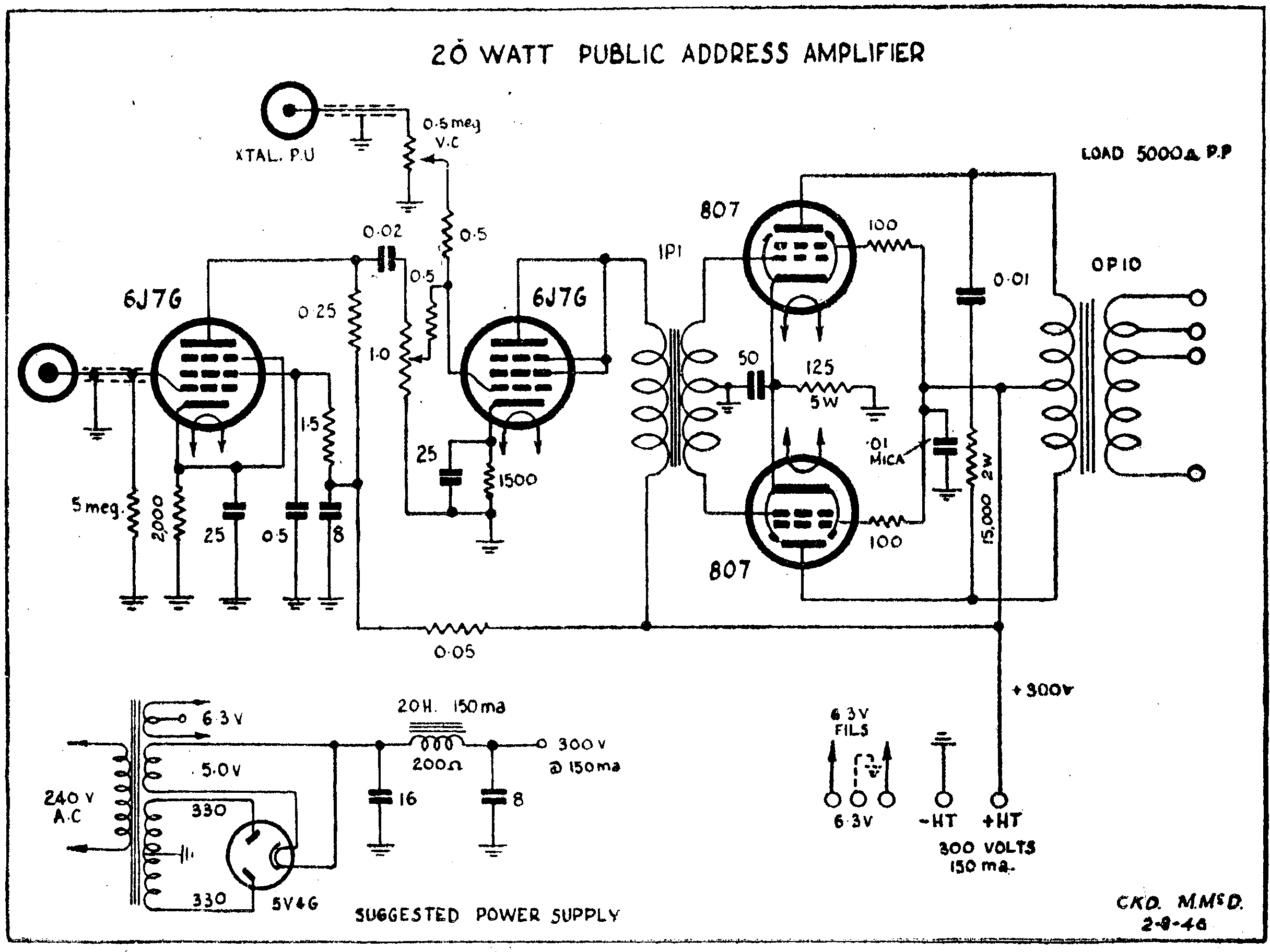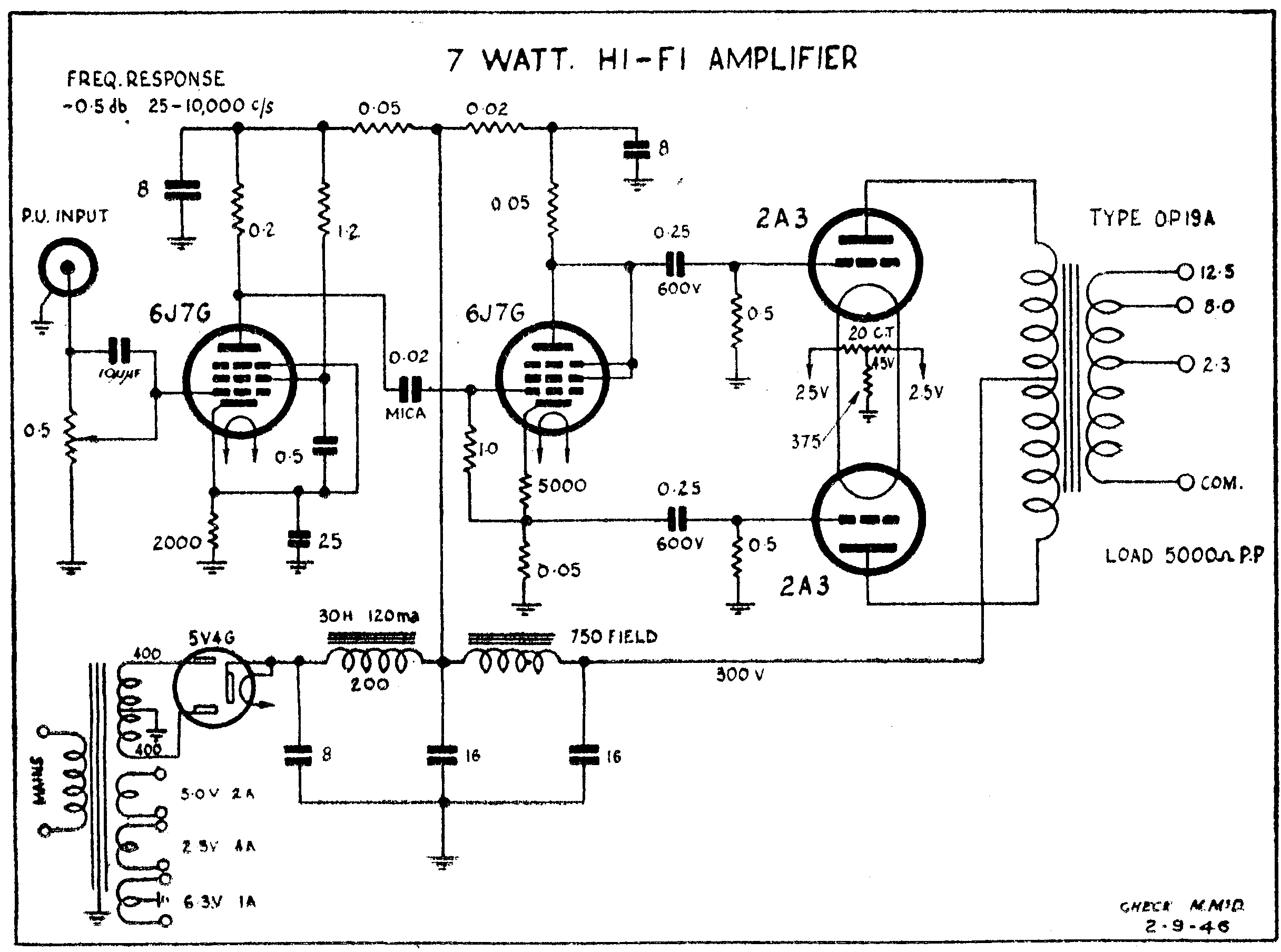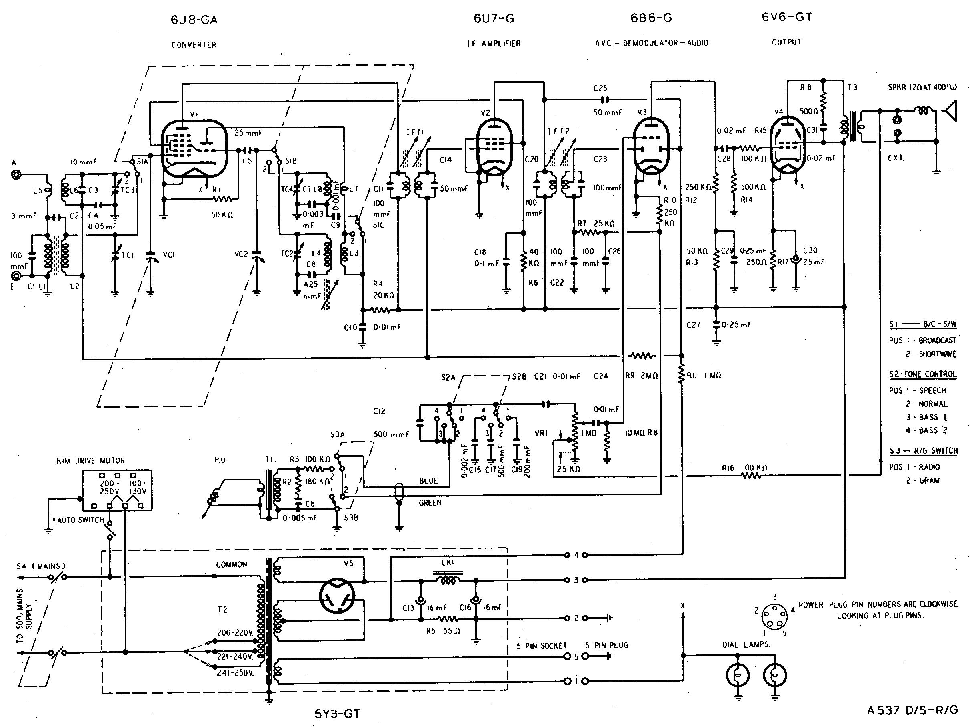
SECTION 8
AUDIO AMPLIFIERS
There are many versions of audio amplifiers, from simple crystal set
amplifiers to public address amplifiers. They usually consist of one or
more power output valves, and one or more preamplifiers. They often
have negative feedback to give a flat frequency response. They may have
tone controls. In a single power output valve which runs in class A, they
suffer from normal faults, leaking coupling capacitors, open cathode bypass
capacitors, shorted tone compensation capacitors in the anode circuit. If
the power output circuit has two valves, then they may be simply connected
in parallel to give more power. Or they may be connected in Push Pull. This
requires a phase inverter as each valve amplifies one half of the cycle.
A driver transformer is an easy way to get the phase inversion with a centre
tapped secondary.

Another way to achieve phase inversion without using a
transformer, is to use a driver valve with a gain of unity. The cathode
circuit has a signal of zero degrees phase and the anode circuit has a signal
of 180 degrees phase. Note that the phase inverter valve has a high cathode
resistor and that it is not bypassed. The output valves need some sort
of negative bias so that they operate in class B or class AB. The bias
can be supplied in several ways, back bias, a battery, a separate negative
supply, or cathode bias. In the circuit with dual 2A3 triodes, the resistor
from the tap to earth is the bias resistor.

If there is negative feedback to control frequency response,
it can be achieved in several ways. Having no cathode bypass capacitor
is one way. Taking output from the speaker coil or plate circuit, back
to the preamplifier cathode is another way. There may be a resistor/capacitor
network to add some compensation. There may be a Tone control in this
network.
If the amplifier has a microphone input, it may be high
impedance for crystal microphones or low impedance for dynamic microphones.
Dynamic inputs often have a matching transformer. If they have a record
player or phono input, the preamplifier may be different.
If low output, check that the speaker is connected to
the correct impedance output tapping. Also check that the cathode bypass
capacitor is good. If there is any hum, check the filter capacitors first,
then change each valve to check for heater cathode leakage. If the valves
are directly heated, then there with be some sort of balancing for the filaments,
either a tap on the transformer winding or two resistors. This may be adjustable.
Sometimes the transformer is mounted so that it can be rotated to reduce
magnetic coupling. This won't be a problem unless a new mains transformer
has been fitted. Try reorientation. Check for corroded earths. Check valve
shields on the preamplifiers.
MICROPHONES
There are many different types of microphones, but they all do the same
thing, which is to convert sound pressure waves into electricity. The method
used will determine the frequency response, the output level and the output
impedance. Crystal microphones have a pietzo crystal, have a high output
and high impedance and can directly drive an amplifier. Dynamic microphones
have a moving coil in a magnetic field connected to a diaphragm, and have
a low output impedance and level. They usually need an input transformer.
Ribbon microphones have a metal ribbon in a magnetic field, and have a very
low output impedance and need a transformer. Carbon microphones have a low
resistance and need a current to work. They have a low impedance, high output,
and usually need a transformer. Some microphones may have a preamplifier
in them, and so will need power supplied. Higher quality microphones have
a method of changing the direction in which they receive the sound. This
can be simply a masking method to control how the sound reaches the
microphone.
Common faults are broken wires and connectors, as microphones
are often moved, especially when hand held. They are always dropped, so physical
damage to the case and element are common. Check and fix any damage. Replace
the element if broken. Check that any masking devices function. Check the
frequency response. It is not absolutely flat, but it should suit the intended
use, speech or music. An easy way is to put the microphone in a padded cardboard
box, with a small speaker. Connect the speaker to an audio signal generator,
and the microphone to an amplifier an oscilloscope. Change the audio signal
generator, and look at the signal for distortion and level. Remember that
the speaker is not perfect, so allow for it. Try different audio levels,
soft and normal.
RECORD PLAYERS
A record player may have just an audio amplifier, or have a radio as well.
The radio version has an input, after the radio's audio detector, and a switch
connects the input to the record player or radio. A normal
crystal pickup on a record player is high output and has a fairly flat
frequency response, so it can be directly connected to the input. If the
pickup is magnetic, it will have a lower output, and a sloping frequency
response. An RIAA (Recording Industry Association of America) amplifier
is required which corrects the sloping response. Some early HiFi systems
had several frequency responses that could be selected.
Normal faults are noisy switches, and hum. Clean the switch. For hum, check
that the fine wires that connect to the record arm are not broken and are
connected correctly. Simply touching the needle should produce a noise. Always
check the needle, as it is usually dirty, and if so, clean it with water
and a fine brush. Be gentle. Look at the needle with a magnifying glass to
check for wear, and replace if worn. Check the counter-balance under the record
arm, that the spring is working and reducing the weight on the needle.

TURNTABLES
The turntable has a round platter driven by a motor with some type of
gear reduction. The early types were a single speed. Later types had some
sort of gear change, to allow the playing of the older 78 RPM records, 45
RPM singles, 33 RPM albums, and 16 RPM speech records. Often it was a stepped
motor shaft, with an idler wheel that moved from place to place, to change
the ratios. The idler wheel runs on the inside of the platter, and is moved
by a lever.
The idler wheel will lose its rubber completely, or get
a flat where it has been resting against the platter or motor for many years.
This will cause it run at the wrong speed, or give an audible bump in the
sound. Replace the wheel. If the record runs at the wrong speed, put a stroboscope
on the platter, and shine a normal mains powered light on it. The 50hz flashing
of the light, should show a steady pattern on the stroboscope. If running
slow, check and lubricate the bearings. Change the idler wheel. Check that
the motor is made for 50 hz and not 60 hz. Some motors had a spare shaft,
and you could fit the one for your mains frequency.